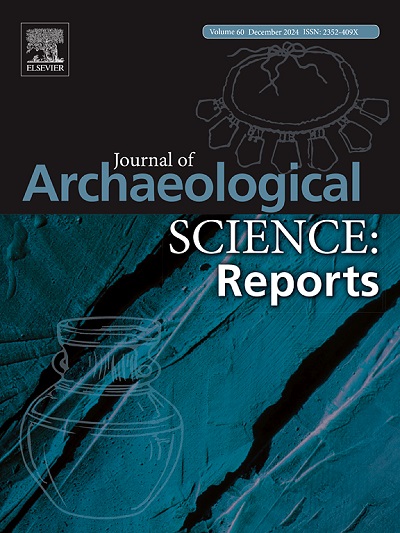东罗马尼亚平原新石器时代早期陶工使用的白色颜料的电子顺磁共振和判别分析
IF 1.5
2区 历史学
0 ARCHAEOLOGY
引用次数: 0
摘要
为了证明罗马尼亚平原新石器时代早期到旧石器时代中期族群之间的相互影响和物质交流,我们利用电子顺磁共振(EPR)对 103 块陶瓷碎片的白色颜料进行了研究。由于 Mn2+、Fe3+ 和铁磁簇 EPR 光谱的叠加比例不同,所有被研究的碎片都显示出复杂的 EPR 光谱。这样就可以开发出一种新的程序,提取一组五个数字参数来量化记录的光谱,这些参数是判别分析的基础,能够按遗址或文化传统对它们进行比较。通过这种方法,可以证明最早的新石器时代人类(Starčevo-Criș)利用多种原材料来源,而较近的族群(Vădastra、Hamangia、Boian、Gumelnița)则依赖于更多的本地化来源。这表明该地区积累了有关原材料来源的知识,从而利用了具有最佳技术特性的原材料。夏尔科石器群落的这种知识积累与来自安纳托利亚的复杂人口迁移过程有关,也与在不同时期居住在同一遗址的史前先民和后代有关。因此,本研究提出的考古计量分析为居住在罗马尼亚平原 2000 多年(约公元前 6200-3800 年)的新石器时代和旧石器时代族群的行为提供了间接的代用指标。本文章由计算机程序翻译,如有差异,请以英文原文为准。
Electron paramagnetic resonance and discriminant analysis of white pigment used by Early Neolithic potters in the Eastern Romanian Plain
To evidence the reciprocal influence and material exchanges between Early Neolithic to Middle Chalcolithic communities from Romanian Plane, the white pigments of 103 ceramic fragments was investigated by Electron Paramagnetic Resonance (EPR). All investigated fragments showed a complex EPR spectrum due to the superposition, in different proportions, of the Mn2+, Fe3+ as well as iron ferromagnetic clusters EPR spectra. This permitted to develop a new procedure for extracting a set of five numerical parameters to quantify recorded spectra, parameters which were the basis for a Discriminant Analysis able to compare them by sites or by cultural traditions. In this way, it was evidenced that the first Neolithic people (Starčevo-Criș) utilized multiple raw material sources, while the more recent communities (Vădastra, Hamangia, Boian, Gumelnița) relied on more localized sources. This indicates an accumulation of knowledge about the raw material sources in the area, leading to the utilization of those with optimal technological properties. This accumulation of know-how by Chalcolithic communities is linked to complex processes of population movements from Anatolia, as well as the ancestral and descendant prehistoric populations that inhabited the same sites in different time horizons. Thus, the archaeometric analysis proposed by this study offers indirect proxies regarding the behaviors of Neolithic and Chalcolithic communities that inhabited the Romanian Plain over 2000 years (ca. 6200–3800 cal BCE).
求助全文
通过发布文献求助,成功后即可免费获取论文全文。
去求助
来源期刊

Journal of Archaeological Science-Reports
ARCHAEOLOGY-
CiteScore
3.10
自引率
12.50%
发文量
405
期刊介绍:
Journal of Archaeological Science: Reports is aimed at archaeologists and scientists engaged with the application of scientific techniques and methodologies to all areas of archaeology. The journal focuses on the results of the application of scientific methods to archaeological problems and debates. It will provide a forum for reviews and scientific debate of issues in scientific archaeology and their impact in the wider subject. Journal of Archaeological Science: Reports will publish papers of excellent archaeological science, with regional or wider interest. This will include case studies, reviews and short papers where an established scientific technique sheds light on archaeological questions and debates.
 求助内容:
求助内容: 应助结果提醒方式:
应助结果提醒方式:


